LINEAR OPTIMIZATION
LINEAR OPTIMIZATION

I have one week left of The Analytics Edge on edX, so I started searching for a new programming/ data/ analytics/ computer science/ R/ whatever class to take after I’m finished. Although, I won’t start immediately because there are some things I want to do first.
When we’re not in R, I take handwritten notes during all of the lectures. However, as soon as R is open, I type all of my notes or hints into the R console.
That way, when I type the commands, I can include notes to remind me what I did in case I forget the meaning of certain arguments. I then save it as a text file for later review. This is all well and good, except for the fact that I have a separate text file for every lecture and quiz/assignment and it’s difficult to find the correct notes without opening multiple files.

And I can’t search within the folder they’re in for specific phrases or commands. Granted, I could easily resave everything into a type of file that can be indexed in Windows, but my notes are messy to say the least and they need some work.
I decided that I’ll go through all of my lectures and retype all of the pertinent information I need to recreate any statistical analysis I may use again, along with any notes I find important. That will make it a lot easier and cleaner to review and I’ll know exactly what to do in the future.
That may take me a week. It may take a day. I’m not sure yet. I do want to take at least a week off before I delve into a new class, so I’ll probably take my time with those notes.
I did a similar thing with trigonometry this week. I stretched the remaining lessons on Khan Academy over the week because I was a little burnt out on nonstop math from the previous week.
Current Search Results
Searching for classes hasn’t been as easy as I expected. There is a ton of relevant coursework, but I haven’t found exactly what I’m looking for yet.
Some of the more interesting classes required programming or mathematics knowledge I don’t have yet. Others sound great and I meet the prerequisites, but the reviews are horrible and I don’t want a repeat of the R class I originally attempted on Coursera.
It’s difficult to find R or machine learning classes because you generally need more advanced calculus or linear algebra knowledge. I found one beginner’s course, but it sounds pretty similar to The Analytics Edge. It covers a lot of the same topics, but it does add several that I haven’t experienced yet.
So far, that may be my best choice. It would be good to review what I learned thus far, and add on some new skills.
I learned about linear optimization in analytics this week (more on that in the next section). I had some issues with it, so I’ve considered looking for a class that delves more in depth into that field.
I probably won’t do a thorough search of classes until analytics is over, but I wanted to see my options so I can have an idea what I’ll do next.
Linear Optimization in Analytics
Linear optimization. I don’t know why I don’t like it. It’s not all that difficult to understand. It’s useful in a lot of fields. As an aspiring data scientist, I will probably use it frequently in my future career.
But I don’t like it.
Linear optimization is basically used to make businesses more efficient or profitable. It takes certain variables and decides on the most optimal combination. We used it to decide how many regular vs discount seats should be assigned on a flight, or which company advertisements should be placed on Google based on specific search terms.

This is all done on a spreadsheet, with Excel, OpenOffice, or LibreOffice. I have Excel, but some of the commands in the lecture (which is taught using LibreOffice) are different, so I downloaded OpenOffice.
You select the parameters for each variable (i.e.: greater than zero, can’t be over a certain number, the sum has to equal a specific amount, etc.) and an objective. From there, the solver tells you the best values for those parameters.
It seems easy enough, but I had some trouble creating the spreadsheets from scratch. All of the lectures provided a premade spreadsheet, but the assignments did not.
I’ve attempted to avoid Excel most of my life whenever possible. I can and have used it, and it’s incredibly useful for a lot of applications, but there’s something about it (and spreadsheet programs in general) that I don’t enjoy using.
That’s why, as I mentioned above, I think it may be a good idea to take a course specifically on linear optimization, or even spreadsheets in general. I feel as though I need to get over my bias of spreadsheets. It’s such an odd thing to have negative feelings for.
As difficult as R is for me, I have none of those feelings there. It’s only against spreadsheets. Perhaps taking a course will help me appreciate them more. I think my final week of analytics also utilizes spreadsheets, so I’ll see how I feel at the end. Right now, it seems to be a good idea.
Trigonometry
I have completed trigonometry! Gosh, it feels like just last week that I finished algebra II.
That’s because it was last week and most of the trig lessons were mixed in with geometry and algebra II, so there wasn’t much left to take!

The biggest part of trig this week was the use of trig identities and a more in depth study of the unit circle.
Trig identities involve the use of sine, cosine, and tangent, along with all of their variations and derivatives. I had forgotten most of them, so these lessons were incredibly useful and helped me understand them better.
In algebra II, I always had trouble with sinusoidal functions (graphs of sine and cosine). While taking a quiz on them in trig, it all suddenly clicked and they made sense to me. I’m not sure why, but the different ways to manipulate them and the resulting graphs were finally understandable.
The unit circle is a circle with a radius of 1, which is centered around the origin of a graph. It’s useful in understanding trig identities, the locations of points around the circle, and visualizing π. It’s also used to prove the Pythagorean Identities. Cool stuff!

My next math class is precalculus. I haven’t decided whether I should start that or take statistics first.
Statistics is an incredibly large part of data science, machine learning, and analytics. It was, in fact, what the majority of The Analytics Edge was centered around.
My original intention was to take it after completing linear algebra. However, after using so much statistics in analytics and looking at potential courses, it may be useful to take it before diving into calculus. I have been able to do all of the statistical analyses in R, but it would be beneficial to understand all of the statistical formulas and how they work, rather than blindly entering data into the console.
I’m not sure yet. On the flip side, calculus and linear algebra will help me understand machine learning algorithms. But it’s going to be a very long time before I complete linear algebra. Spending one month (presumably) to take statistics first won’t realistically impact my timeline. I have to take statistics before or after, or both, so I may actually take it first.
I think I just answered my question!
Conclusion
I’m sorry about the rather disjointed journal entry this week. Hopefully you found it interesting or entertaining nonetheless. I’ll let you know next time how my last week of analytics went and whether or not I’ve changed my mind about my next math class.
Thanks for reading. Keep dreaming and I’ll see you next week!

Author and hobby digital artist. Barry aspires to become a data scientist and better himself as a person.